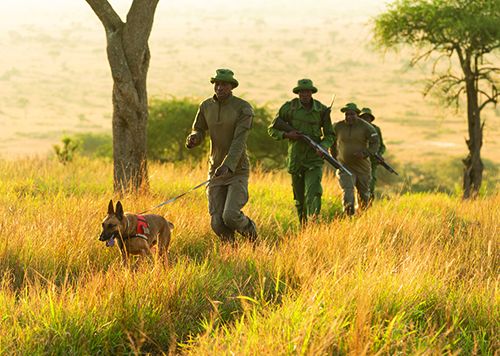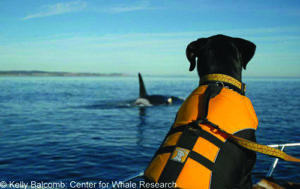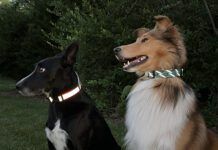
We don’t usually think of dogs as the best friends of elephants, whales, hedgehogs, Chinese Moon Bears, bandicoots, or white-footed voles, but their incredible noses make a difference in the lives of these and other endangered species. Dogs are increasingly being put to work as valuable tools to both protect endangered species and combat invasive species that can destroy habitat for native plants and animals. We hope that when you read about some of the amazing things they can do, you will be inspired to put your dog’s nose to work – if not for conservation, at least just to give your dog an engaging activity that provides a great workout for body and brain.
- Preventing elephant poaching. From 2010 through 2012, poachers killed an average of 33,630 elephants every year, resulting in more than 100,000 deaths across the continent, according to the International Union for Conservation of Nature. However, thanks in part to U.S. Army software and sniffer dogs, Kenya has significantly reduced the number of animals killed in that country since 2013.
According to its Canines for Conservation Program, the African Wildlife Foundation combats illegal wildlife trade by placing ivory detection dogs and their handlers at key airports and seaports throughout the continent. By detecting tiny amounts of ivory or rhinoceros horn dust, officials can prevent traffickers from exporting wildlife contraband. The dogs are also trained to find guns, which, because they are difficult to obtain, are typically used by multiple poachers. In his first week of field work, Ruger, a mixed-breed dog working with the Department of National Parks and Wildlife in Zambia, found 13 guns, putting an estimated 150 poachers out of business.

Headquartered in Missoula, Montana, Working Dogs for Conservation calls itself the world’s leading conservation detection dog organization. Its website (WD4C.org) describes its mission: “Building upon techniques from narcotics detection, cadaver detection, and search and rescue, we pioneered ways to use dogs’ extraordinary sense of smell to protect wildlife and wild places. Our dogs can detect weeds before they break the surface, animals that live below ground, and aquatic organisms invisible to the human eye. Our co-founders were the first to train dogs to detect wide-ranging carnivores non-invasively, to uncover illegal snares in Africa, and to find invasive plants, insects, and fish.”
In 2013, the San Jose Mercury News interviewed Megan Parker, the organization’s Director of Research, about Pepin, her Belgian Malinois. Pepin was trained to track the poop or scat of endangered wildlife. “Scat is a gold mine of information,” Parker explained. From scat, scientists can extract DNA to check the sex of animals, discover family relationships, evaluate diets, test hormone levels, check for diseases, and map an animal’s home range. This information helps conservationists monitor endangered animals without having to trap, tag, or hunt them. Pepin tracked endangered fox kits in California and endangered gorillas in Cameroon (to name just a few) by their scat.
All of the organization’s dogs live with their handlers, train at least twice a week, and are rewarded with favorite toys. Most of them were adopted from shelters, where, typically, they displayed such high energy and hyper-focus on toys and play that they were found to be unadoptable by most members of the public. WD4C describes their candidates this way: “Great conservation detection dogs have an obsessive play drive and an unrelenting toy focus. Their never-quit attitude makes them nearly impossible to keep in a family home, but perfect members of the WD4C family.”
WD4C feels so strongly that the best candidates for conservation work are often found in shelters, that it created a program, Rescues 2the Rescue, through which they teach shelter staff how to identify dogs that would make ideal candidates for this work and to connect them with organizations that could adopt and employ them. WD4C says its next step is to create ways for working dog organizations to evaluate candidate dogs, “so that more of these talented, at-risk animals can be placed in successful, fulfilling careers.”
If you would like to support the work of WD4C, or are interested in developing a conservation dog project, WD4C can advise on performance, husbandry, training issues, troubleshooting, novel scents or techniques, or help with any other aspect of conservation dog work; the group supports others and the field. See WD4C.org for more information.
- Detecting wildlife products. In India, German Shepherd Dogs are used to detect products such as tiger skins, ivory tusks, and the bones of endangered birds. They are also trained to locate injured animals, which helps authorities arrest poachers quickly. The program, which is jointly conducted by the World Wildlife Fund and a wildlife trade-monitoring network, plans to train more dogs to decrease animal poaching across the country.
- Rescuing Australia’s koalas. In Australia, where brush fires burning since September 2019 have ravaged the continent and killed more than a billion animals, dogs are saving koalas. Detection dogs are trained to identify koala fur, whose scent falls from trees in which koalas reside. When high winds, heat, and other conditions interfere, the dogs search for koala scat to identify where the animals have been so that human experts can scan the appropriate trees and find them.
Some koala-sniffing dogs have become celebrities in their own right, such as Bear, a detection dog from the University of the Sunshine Coast in Queensland, Australia. Bear and his handler made several television appearances explaining how the koalas Bear finds are given health checks, medical treatment as needed, and are released into the wild wearing GPS collars that allow researchers to keep track of them. Bear’s obsession is any toy that anyone will throw for him, so once he became familiar with the scent of koalas, his chase-the-toy rewards arrived whenever he successfully indicated a “find.”
- Helping bandicoot populations recover. Five years ago, the Werribee Zoo in Victoria, Australia, raised funds to train livestock guardian dogs (LGDs) to protect the endangered eastern barred bandicoot from predators. The bandicoots, which are small, shy, solitary, nocturnal marsupials, were extinct in the wild but could be found in public zoos across Australia and were being released in selected locations to re-establish their populations. Previous attempts to release bandicoots into the wild failed as the animals fell victim to foxes and cats.
Maremma LGD dogs are a livestock breed native to Italy, and they can be trained to chase predators away while maintaining a respectful distance from the animals they protect. Before being introduced to bandicoots, Maremma LGDs successfully protected colonies of penguins.
- Tracking whales by their poop. On the opposite side of the world, off the coast of San Juan Island, Washington, a black Lab-mix named Tucker leaned over the bow of the research vessel Moja and sniffed the air. His goal? Finding orca whale scat, which he could detect in open water up to a mile away and in the tiniest of pieces.
Because scat can sink or disperse in less than half an hour, finding it isn’t easy. But it’s worth the effort because examining their fecal matter helps researchers study the 85 orcas, or killer whales, that live just north of Seattle. The orcas have been tracked for decades, and their declining numbers concern scientists.
Unlike other detection dogs, Tucker couldn’t just approach his target and sit to signal a find. He had to guide the boat to the right area, then wait while researchers noticed and retrieved the material.
Today there are several scat-detection dogs in the Conservation Canine program at the University of Washington’s Center for Conservation Biology, but Tucker holds a special place in the program’s history. When he retired at age 13 in 2017, Tucker had helped find the majority of the 348 fecal samples analyzed in the orca research project.
Like the trainers of other scent-detecting dogs around the world, those who work with conservation dogs look for dogs with drive and focus. A Flat-Coated Retriever named Sadie was donated to the program because of her ball addiction. In frustration, her owner put Sadie’s ball on top of the refrigerator, and eight hours later Sadie was still sitting there, staring at the ball. “When the owner told me that story,” said biology professor Sam Wasser, Ph.D., director of the orca scat research project, “my immediate response was, ‘We’ll take her.’”
Professor Wasser is the lead author of a study on the challenges facing today’s orcas. “A lot of whales are getting pregnant, but they are losing a large portion of their pregnancies,” he explained. “They don’t have enough food.” The orcas feed primarily on Chinook salmon, and with declines in the Chinook population, their food supply is shrinking. Dr. Wasser said that when Tucker retired, an Australian Cattle Dog named Jack took his place, but with overfished salmon and fewer whale sightings, Jack may not be as busy as Tucker was.

For decades, conservation biology has been a field of study at the University of Washington in Seattle, and since 1997, dogs have played a key role in the department’s research. That’s when Dr. Samuel Wasser, Director of the Center for Conservation Biology and Conservation Canines, began using dogs to help find threatened and endangered species. He and Sgt. Barbara Davenport, Master Canine Trainer with the Washington State Department of Corrections, adapted dog-training methods used to train narcotics- and arson-detecting dogs to help dogs locate the scat, or feces, of endangered animals around the world.
Scat is important in wildlife research because it offers genetic, physiological, toxicological, and dietary indicators of species abundance, distribution, resource use, physical health, and response to environmental pressures. Scat-detection dogs routinely out-perform traditional wildlife detection methods such as the use of remote cameras, radio-collaring, hair snags, and trapping.
Scat-detection dogs are selected for their trainability, temperament, play drive, and strong object orientation. They are intensely focused and have an insatiable urge to play. Their obsessive personalities are incompatible with most families, so they are often given up for adoption, but their single-minded drive makes them perfect for conservation work. The Conservation Canines website says its dogs “are happy to work all day traversing plains, climbing up mountains, clambering over rocks and fallen trees, and trekking through snow, all with the expectation of reward – playing with their ball – after successfully locating wildlife scat. We rescue these dogs and offer them a satisfying career traveling the world to help save numerous other species.”
For information about contracting for the Center’s services, or to contribute to its Friends of Biology Fund, visit conservationbiology.uw.edu/conservation-canines.
- Finding tiny animals for research. Laura Finley is a U.S. Fish and Wildlife Service biologist involved with fishers, which belong to the weasel family. In northern California, researchers used to catch fishers, anesthetize them, punch holes in their ears to hold tags, and draw blood – and then repeatedly recapture them to monitor their population and area.
There’s an easier way, as a University of Washington team demonstrated when they worked with two dogs for six weeks and found 700 fisher scat samples, more than the wildlife service could analyze.
A more mysterious target is the white-footed vole, a rodent so difficult to find that it is almost mythical. Native to redwood forests in Northern California and parts of Oregon, the vole looks like a mouse but has a rounder head and stouter body. This small rodent is believed to spend part of its life in trees and another part in burrows in the ground.
To help scientists find and study white-footed voles, researchers experimented with different detection methods, including pitfall traps and trail cameras. Detection dogs may be the most promising method. Wicket, a detection dog with Working Dogs for Conservation, tracked invasive snails in Hawaii, elephants in Africa, grizzly and black bears in Canada, rare Moon Bears in China, and invasive Chinese Bush Clover in Iowa. Researchers hope that Wicket and dogs like her will help them understand the voles’ place in the redwood ecosystem, in the food chain, and in a slowly changing habitat.
Frehley, a Border Collie rescued by Conservation Canines from the Seattle Animal Shelter in 2005, learned to track New Mexico’s endangered Jemez Mountains salamander by studying its scat and part of a broken-off salamander tail.
Hedgehogs are small mammals that thrive in hedges and underbrush, where they search for insects. Despite their porcupine-like appearance, hedgehogs have thousands of soft, smooth spines and are safe for humans to handle. In England, where hedgehog populations are in sharp decline, conservation organizations offer advice and assistance to those who have backyard hedgehogs, keep hedgehogs as pets, would like to encourage them in their yards, or want to help injured hedgehogs.
In August 2019, the London Daily Mail reported that Henry, a three-year-old Springer Spaniel, had been trained to detect hidden hedgehogs as far as 250 yards away. Henry indicates his finds by sitting, and then his handler comes to investigate. Henry helps rescue hedgehogs threatened by land development projects. Because they live in dense undergrowth and long grass, hedgehogs are in danger wherever land is cleared. The hedgehog project, which will run until May 2020, is overseen by staff at Hartpury University in Gloucester. If the trial is successful, other dogs will be trained to aid hedgehog conservation.
- Detecting invasive species. Conservation dogs do more than track endangered species. They help identify and prevent the spread of invasive species, both plants and animals.
• According to Darren Ward, Ph,D., who studies ants at the University of Aukland, New Zealand, sniffer dogs have been trained to assist with eradication programs of non-native red fire ants in Australia and Taiwan, electric ants in Australia, and small colonies of Argentine ants in New Zealand.
• In 2013, the conehead termite began to cause serious damage in Dania Beach, Florida. The Florida Department of Agriculture worried that it could spread throughout the state the way the Formosan termite has spread along the south Florida coast. Because this termite travels above ground, it can spread faster than other species while eluding standard pest-control methods. Connie, a mixed-breed dog adopted from a shelter, was selected for her youth, energy, and long legs, which help her work in tall grass. The nests Connie discovered were removed, packed in garbage bags, and burned or fumigated. So far, the termite is under control.
• In the northern United States and Canada, the zebra mussel has invaded lakes, rivers, and wetlands, clogging water intake pipes, cutting swimmers’ feet, disrupting the natural ecosystem, and harming native fish and wildlife. Minnesota’s Department of Natural Resources was one of the first to use sniffer dogs to find these invasive animals. Human inspectors searching boats being hauled into and out of Minnesota lakes often missed zebra mussels, allowing them to multiply and become even more of a nuisance. In 2013, the DNR added three mussel-detecting dogs to its team of more than 140 human inspectors.
“The dogs are going to be able to inspect watercraft and vessels a lot faster than humans,” said Travis Muyres, one of the conservation dog handlers. “A lot of the time they’re more successful because they’re using their noses instead of their eyes.”
In Canada, concern about zebra and quagga mussels has made inspections mandatory for any watercraft, from stand-up paddleboards to motorboats. Alberta’s inspection crews now include three mussel-sniffing dogs.
• In Kosciuszko National Park in Australia, a pretty perenniel threatens agriculture and the environment. The orange hawkweed (Hieracium aurantiacum), native to Europe and a member of the daisy family, grows in remote alpine areas close to the ground with leaves in a flat circular pattern. Because of its attractive flowers, hawkweed was sold as an ornamental plant in New South Wales, but when it became naturalized and was recognized as a danger to native species, conservationists focused on eradicating the plant. To help human inspectors find and destroy the plants, two “botanist puppies” are on the job.
In 2016, weed management officer and dog handler Hillary Cherry explained the project to ABC News in Australia. “The dogs can differentiate one plant from another,” she said. “We were doing an evaluation the other day and running through dense scrub and one of the dogs turned quickly, ran back, put her nose underneath a big, thick patch of scrub, and found a patch of hawkweed seedlings. We never would have been able to find them. The dogs’ ability is so strong and powerful, it blows us away every time.”
Montana resident CJ Puotinen is the author of The Encyclopedia of Natural Pet Care and other books. See “Resources,” page 24, for book information.




